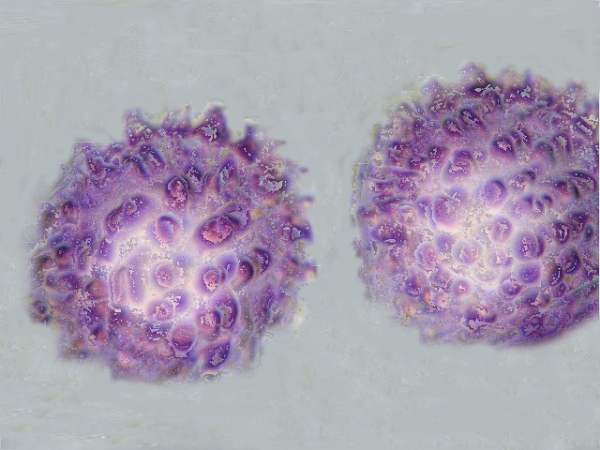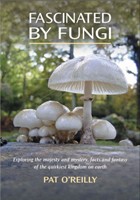Scutellinia trechispora (Berk. & Broome) Lambotte
Phylum: Ascomycota - Class: Pezizomycetes - Order: Pezizales - Family: Pyronemataceae
Distribution - Taxonomic History - Etymology - Identification - Reference Sources
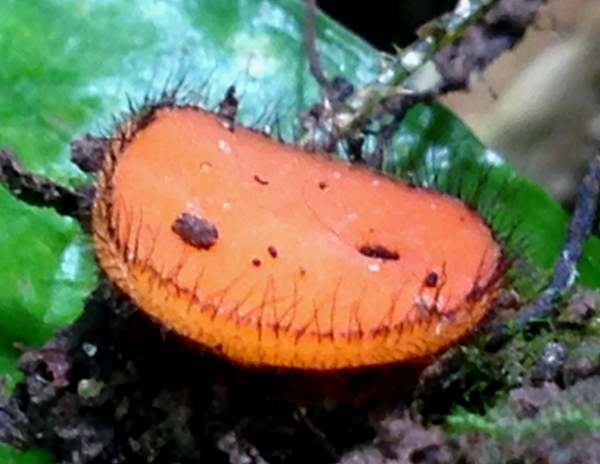
This red/orange, short-haired, disc fungus belongs to the 'spore shooter' phylum, the Ascomycota (commonly referred to as the ascomycetes). It is one of the thirty or so Scutellinia species found in the UK. Many guide books only include one species of Scutellinia - Scutellinia scutellata, the Eyelash Fungus', as it is commonly called - probably because microscopy is always required to identify with any certainty members of this genus.
Distribution
Although recorded throughout Britain and Ireland this is rather an uncommon find. The specimens shown on this page were found in southern England. Scutellinia trechispora is reported from several European mainland countries and is also listed, under the pseudonym Sphaerospora trechispora, in F.J. Seaver's 1928 publ;ication 'North American cup-fungi (operculates)'.
Taxonomic history
When British mycologists Rev. Miles Joseph Berkeley and Christopher Edmund Broome described this species in 1846 they placed it in the genus Peziza, giving it the scientific name Peziza trechispora. In 1887, when Belgian mycologist Jean Baptiste Emil Lambotte (1832 - 1905) reviewed this ascomycete fulgus, he renamed it Scutellinia trechispora, and this is the binomial scientific name by which it is generally accepted today.
Synonyms of Scutellinia trechispora include Peziza trechispora Berk. & Broome, Lachnea trechispora (Berk. & Broome) Gillet, Sphaerospora trechispora (Berk. & Broome) Sacc., and Ciliaria trechispora (Berk. & Broome) Boud.
Etymology
Scutellinia, the genus name, comes from the Latin noun scutellus, meaning a small shield or bowl. The specific epithet trechispora is derived from the Greek trekhùs meaning rough - hence trechispora is a reference to the rough surfaces of spores of this eyelash fungus.
The key to identifying to species level the various species of Scutellinia and Cheilymenia (the other main group of eyelash-fringed disc fungi) of which there are close on 50 known in Britain and Ireland, is by microscopic examination of asci, spores and any hairs or 'lashes' that cover the infertile surface.
Identification Guide
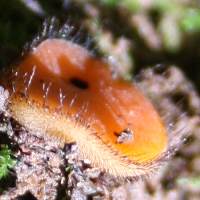 |
BodyUpper (fertile) surface an orange-red disc with a slightly raised margin, up to 1cm across fringed with rigid thick-walled multi-septate hairs around the margin. Outer surface (excipulum) reddish brown, also covered with thick-walled, sharply pointed, multi-septate, brown hairs
|
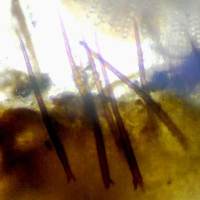 |
HairsUp to 1100 x 20-40µm, septate, some but not all are forked at the base; brown, sharply pointed. There are some shorter 1-septate hairs among the long hairs.
|
 |
SporesSpherical, verrucose, hyaline, 18 - 22µm in diameter; warts are bluntly conical, 2 - 4µm tall and typically 2µm across. Spore printWhite. |
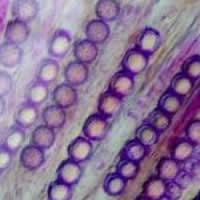 |
Asci and paraphysesThe cylindrical, thin-walled asci are 250 - 300 x 19 - 25µm, and this is where the spores mature (eight spores per ascus). The club-shaped 'packing' between the asci are called paraphyses and are 2.5 - 4µm in diameter, expanded to 6-10µm at the apex. Together the asci and the paraphyses make up the fertile upper surface of the disc. When the spores are mature they are 'shot' from the asci under pressure. |
Odour/taste |
Not distinctive. |
Habitat & Ecological role |
Often among mosses but also on bare soil between plants. The specimens shown on this page were found in the Forest of Dean. |
Season |
Spring and summer. |
Similar species |
All of the Scutellinia fungi appear quite similar to the naked eye, and a microscope and quite a lot of experience is needed to tell them apart. Sarcoscypha austriaca, the Scarlet Elf Cup, is much larger and deeper, bright red and grows on dead twigs and branches in mossy woods and sometimes under damp hedgerows; its rim is not fringed with hairs. |
Reference Sources
Y.-J. Yao and B.M. Spooner (1996). Notes on British species of Scutellinia. Mycological Research Volume 100, Issue 7, July 1996, Pages 859–865.
René Dogoud. Vincent Ruiz-Badanelli (2010). Sur deux espèces du genre Scutellinia, sous-genre Legalia T. Schumach., Scutellinia minor et S. mirabilis : Ascomycete.org, 2 (1) : 25-31.
Schumacher T. (1990). The genus Scutellinia (Pyronemataceae).Opera Botanica 101: 107 pp.
Schumacher, T. (1988). The Scutellinia battle: the lost, missing and dead. Mycotaxon 33: 149-189.
Dennis, R.W.G. (1981). British Ascomycetes; Lubrecht & Cramer; ISBN: 3768205525.
Breitenbach, J. & Kränzlin, F. (1984). Fungi of Switzerland. Volume 1: Ascomycetes. Verlag Mykologia: Luzern, Switzerland.
Medardi, G. (2006). Ascomiceti d'Italia. Centro Studi Micologici: Trento.
Pfister, Donald H., (1982). A Nomenclatural Revision of F. J. Seaver's 'North American Cup-fungi (Operculates)' Occasional Papers of the Farlow Herbarium of Cryptogamic Botany No. 17 (August, 1982), pp. 1-32
Paul M. Kirk, Paul F. Cannon, David W. Minter and J. A. Stalpers (2008). Dictionary of the Fungi; CABI.
Taxonomic history and synonym information on these pages is drawn from many sources but in particular from the British Mycological Society's GB Checklist of Fungi.
Acknowledgements
This page includes pictures kindly contributed by Simon Harding.
Fascinated by Fungi. Back by popular demand, Pat O'Reilly's best-selling 450-page hardback book is available now. The latest second edition was republished with a sparkling new cover design in September 2022 by Coch-y-Bonddu Books. Full details and copies are available from the publisher's online bookshop...
